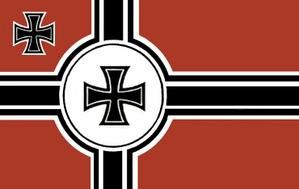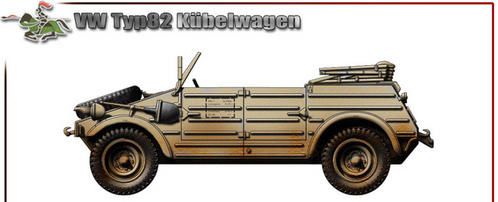


The Volkswagen Type 82 was a military derivation of the Volkswagen 'People's Car' which dated back in conception to 1933 when Hitler asked the noted automobile engineer Dr. Ferdinand Persche to design a simple and inexpensive car which would put motering within the financial reach of all. Early in 1934 Porsche completed detailed specifications for approval and was given the go-ahead to make prototypes and two pre-production batches of 30 cars each for testing and demonstration. The vehicle was to have a 996cc rear-mounted air-cooled engine and was to be sold at DM 1,000. A new factory was to be built at Wolfsburg to produce the new car in quantity. The Boldswagen was a small streamlined sedan and over five decades later the developed version of this same basic design remains familiar all over the world as the Volkswagen 'Beetle', one of the best selling cars of all time. The Volkswagen car did not, in fact, enter producion until after 1945, however, for in 1939 Germany marched into Czechoslovakia and war became inevitable.
Porsche was asked to design immediately a militarised version of the Volkswagen for the German Army which was still, at this time, less than adequately equipped with motor transport despite the efficiency of its armoured divisions. The military Voldswagen was based closely on the car, utilizing the same rear engine, chassis pan, wheels and suspension. The sedan type body was, however, completely replaced with a simplified box-like open structure reduced entirely to flat panels for ease of production and assembly. The design was ready for approval in December 1939 and some prototpes were sent to Poland for 'field trials' by Panzer divisions. Here the vehicles were favoruabley received being easy to handle and having an excellent cross-country performance. Some ordanance officers had earlier feared that the small rear-mounted engine and lack of four-wheeled-drive would render the vehicle unsuitable for military use. They were proved to be wrong, the Volkswagen Kubelwagen became the most widely used and best-known German vehicle of the war period.
The Volkswagen Kubelwagen was used by all arms of the Wehrmacht including the Navy and Luftwaffe. Production actually astarted in March 1940 and a few vehicles wee in service in time for the invasion of France and Netherlands. General Rommel was, at this time, a divisional general but when he went to take command of the Afrika Korps in 1941 he realised tht Volkswagens would be ideal for use in the desert. Here whole reconnaissance battalions were euqipped with Kubelwagens and the vehicle more than justified its existence. The major demand for Kubelwagens was on the Eastern Front, however, after Germany had invaded Russia in mid 1941. Here the extremes of climate proved as big an enemy as the Red Army at times, and mud and snow proved major ovstacles to troop movements in the winter months. The Kubelwagen was one of the few motor vehicles which proved to be 'at home' in these conditions. Its light weight limited bogging down and it could be manhandled by two men. The Kubelwagen was used by all branches of the Army and Waffen-SS. Roles included staff car, scout car, light ambulance, ammunition carrier, and assault engineer carrier. The latter involved the addition of an extra stores locker in the right-hand rear-seat.





























/idata%2F0396584%2FKOREA%2F71910_korea_MIA1_800.JPG)
/idata%2F0396584%2FU.S.ARMY-POST-WW2%2Fphot4901a.jpg)
/idata%2F0396584%2FDRAWINGS-UNIFORMS-WW2%2F30-451-09b-2.jpg)
/idata%2F0396584%2FP-40%2F44FS000.jpg)
/idata%2F0396584%2FGERMAN-U-BOAT%2FBundesarchiv_Bild_101II-MW-1031-28-_Lorient-_U-31.jpg)
/idata%2F0396584%2FSOVIET-ARMY-WW2%2F1.jpg)




